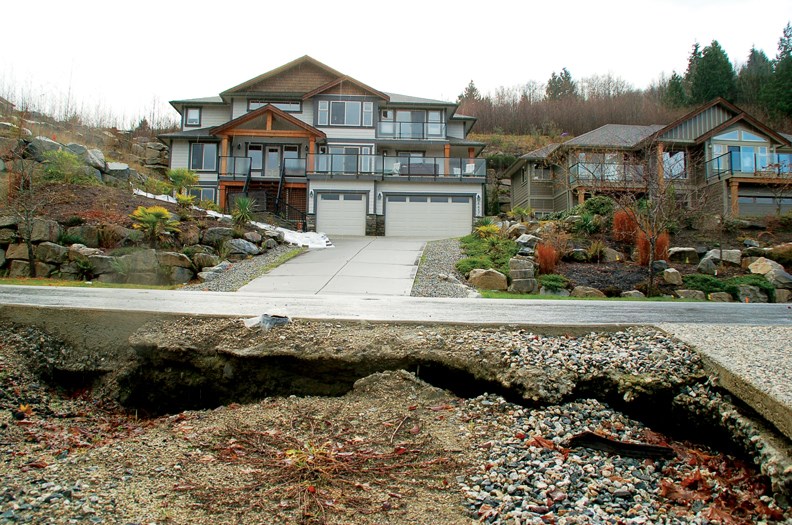A recent Braun Geotechnical review states plainly that ongoing sinkhole development should be expected at the Seawatch subdivision and residents now sit in limbo while the District of Sechelt decides what to do about it.
Options include doing more investigation in the area, attempting to fix the underground watercourse problems leading to the sinkhole formation and abandoning the development altogether.
Sechelt Mayor Bruce Milne encouraged residents to come together in a class action lawsuit last week in order to find “a mutually satisfactory omnibus solution” to the problem.
He noted Ross and Erin Storey, who were forced to leave their home after a sinkhole opened beside it, had already launched a lawsuit naming the District of Sechelt and many others and that the Storeys were looking at switching to a class action suit.
“If the Storeys’ solicitors are successful in engaging the other owners in the subdivision in a class action, then the prospect of reaching a mutually satisfactory omnibus solution will be greatly enhanced,” Milne said during the Dec. 2 regular Sechelt council meeting.
“The process of assigning responsibilities to the various parties involved in the development and maintenance of the subdivision could then commence, and in parallel, negotiations could be underway with the individual homeowners concerning potential resolutions.”
However, the Storeys’ lawyer, Sat Harwood, said this week that his clients were not interested in moving forward with a class action lawsuit, and that the idea had actually been pitched by the District of Sechelt.
“As you can imagine, it’s a very challenging situation up there, and there are lots of different opinions on what’s going on and what the District ought to do to resolve the situation. That lack of unanimity on how to deal with the situation is not conducive to a class action,” Harwood said.
“I think the next step, which everybody is waiting to hear, not just the Storeys but I suspect other people who we don’t currently represent, is to find out what the District’s plans are for the development either in general or with respect to the Storeys in particular.”
Milne said he wasn’t sure what the District’s next step would be, noting the options of doing more investigation, fixing the problems or abandoning the subdivision were too simplistic.
“It’s not quite that black and white,” Milne said.
“We feel at the moment there’s enough surveys and reports and investigations to understand the big picture, so the next question is actually that decision of what we should do, and we have not made that decision.”
Milne said council wants to have at least one more meeting with residents before a decision is made and he noted that meeting would likely happen in the New Year.
“We will ask them what their input would be, having read all the material, looking at the situation, knowing the fiscal, economic and safety issues, what would their advice to council be? And then council’s going to go away and sort that one out.”
Some in the development feel the sinkhole problems cannot be addressed adequately, while others, like Mike and Licia Paddison, say a fix is possible and that the District of Sechelt has a duty to attempt a repair.
“Three years ago I was worried, terrified, I wasn’t sleeping nights, but now we have all the engineering reports, we have a feeling of what’s going on in the neighbourhood. I’m quite confident it can be fixed,” Mike said.
The Paddisons live next to Seawatch Lane where a sinkhole opened in 2012. Work has been done to remediate the problem since then, but the Paddisons say the sinkhole keeps coming back. Currently there are cracks and depressions in the roadway where the original sinkhole opened up, signaling more movement of earth beneath the pavement.
However, the Paddisons say their home has not seen any settling and no cracks are visible in the structure, unlike the Storeys’ family home, which is twisted, cracked and settled due to the nearby sinkhole on their property.
“Obviously the Storeys can never move back into that house,” Mike said, noting it was a “very sad situation for the family,” but he maintains other people’s properties in the subdivision could be saved through remediation.
“The only problem with the majority of the houses in this neighbourhood is the stigma attached to them,” Mike said.
He suggested allowing a geotechnical firm to do a more detailed analysis of the issue to find a permanent fix.
“What we have here is a preliminary understanding of site geotechnical issues. That’s all we have here is a preliminary understanding,” Mike said.
“So you have to finish that work and then once you have all the data, you have to hire an engineering firm and then you have to come up with a solution. And there is always a solution.”
Any solution at Seawatch will likely cost millions of dollars.
A report done for the District of Sechelt in February by Thurber Engineering suggested that just repairing the public and utility corridors (not including remediation on private property such as the Storeys’ lot), rerouting ground water and conducting a “site-wide geophysical and drilling investigation program across accessible areas of the subdivision” would cost an estimated $9.5 million.



